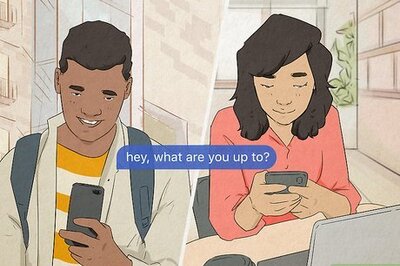
views
THIRUVANANTHAPURAM: A family friend was once heard complaining of the injustice of being asked at a government office for a certificate which proves that he is so and so and is very much alive. The poor soul’s agony-struck face rushes to mind quite often these days when FBying buddies constantly remind of the vital need to be present in the virtual world to be acknowledged alive and breathing, and more importantly, “responding to social realities”.The way social networking sites have engineered a revolution in communication is perhaps the most awe-inspiring phenomenon to have occurred since the advent of the age of Internet. And the way the virtual platforms have become the superhighway on which opinions are generated and social momentum accelerated, a classic sabotage of a system built on monopoly of information and constricted action.The host of networking platforms that have had their sway over the masses at different points of time have all displayed their ability to skyrocket the speed at which information is shared. The early avatars like Classmate.com, Friendster.com and Myspace.com had focused on connecting people. Suddenly, the possibility of bumping into a friend you had known in Kindergarten and who would have been lost by all means in an older world, looked startlingly real. For a while, the sensation was all about bridging the once indomitable forces of time and distance.Though the simple joy of coming across old friends and meeting new people lingers in the air, social networking sites have arrived as the vehicle of social change, making new media the fastest and largest single carrier of mass opinion.Soni Somarajan, Director of a city-based travel agency, and a blogger-cum-Facebook user, puts it as the greatest revolution that has occurred in the past two years. Having followed the Anna Hazare issue on social platforms, he vouches for the support that the Gandhian’s cause has found on FB, Twitter and similar sites.“If you look at the support base Anna Hazare’s strike has had, you would find that it has been created by the live discussions on social networks,” he says. Somarajan also cites the example of the 2011 revolution in Egypt which resulted in the overthrow of the Hosni Mubarak regime. Public protests had escalated after FB groups and Twitter posts calling for mass movements were blacked out along with Internet and mobile services. “Opinion making now happens on a mass scale because thoughts are transferred across a large spectrum in a matter of seconds,” adds Somarajan.He says that being on FB has also done wonders for his eponymous blog. “While I am able to keep contact with my friends by the minute, it also gives me the opportunity to showcase my world and to ensure more more eyeballs. It is basically about cross-reference; friends of my friends also become followers of the blog and I get an immediate feedback on my work. Now, that is something which makes a presence on the social networking sites crucial for survival, especially for writers and media professionals.”Theatre activist Prakash Bare emphasises on the ability of networking platforms to broadcast to the world what is happening at your end without being intrusive. “E-mail is a defentive tool. When you send a mail the person at the other end has no choice but to receive it and feel obliged to reply. One can never be sure if one is intruding into a space where one is not welcome. On the other hand, I see social networking as a safer communication approach,” he says. He regularly posts on FB, the upcoming drama stagings of which he is a part or those which he finds interesting.“Many recent Malayalam films have extensively and fruitfully tapped into the potential of free advertising provided by social media,” says Bare, pointing out the example of 'Salt and Pepper', a run-away hit that was marketed well by the online discussions. “The trend has literally trumped the role of power equations and caucus in the film industry.”However, Bare says he is often confused if not annoyed by the addition of features to sites almost on a daily basis. “Earlier there was this concept of ‘groups’ where you could have a brotherhood of people who share a common interest. Now it has changed to a ‘page’ which I find has lesser life span. One is almost always left trying to figure out one or other new feature. It is as confusing as it is dynamic. But, I do believe that with mobile phones becoming the common man’s communication tool, social networking is going to be the mass media of the times to come,” he says.The flip sides of this mass transfer of thoughts is not to be forgotten, reminds Manoj Puthiyavila, Editor, Vyavasaya Keralam. While he enjoys the discussions on art and music that maintain very high standards, Puthiyavila says he is also apprehensive of the propagation of fanaticism through these sites. “There are quite a number of users who create fake accounts and trigger unhealthy discussions on platforms like these which can do tremendous damage because of the reach they have.” On the other hand, he acknowledges the influence that such new age tools can exert on preserving interests in traditional art forms like Kathakali, which has a group to its credit with a huge following on FB.American theorist David Nye had coined the pharse ‘technological sublime’ to refer to creations that become a point of reference to human beings in their cultural context. The social construct of networking platforms cannot be sidestepped any longer in any dialogue happening in the realm of human interaction. The implications and the impacts are yet to be revealed.

















Comments
0 comment